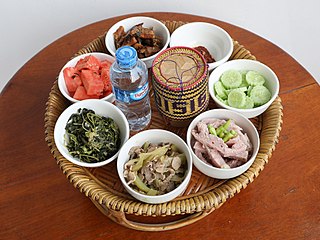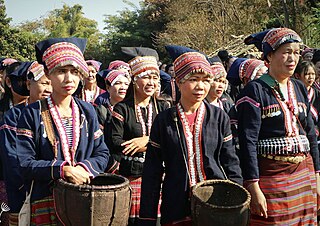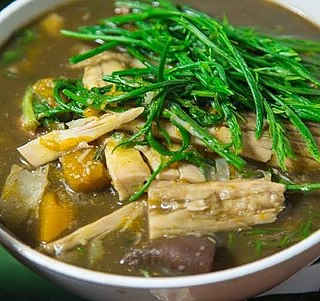
Laos, officially the Lao People's Democratic Republic, is the only landlocked country in Southeast Asia. At the heart of the Indochinese Peninsula, Laos is bordered by Myanmar and China to the northwest, Vietnam to the east, Cambodia to the southeast, and Thailand to the west and southwest. Its capital and largest city is Vientiane.

Lao cuisine or Laotian cuisine is the national cuisine of Laos.

Glutinous rice is a type of rice grown mainly in Southeast and East Asia, and the northeastern regions of South Asia, which has opaque grains, very low amylose content, and is especially sticky when cooked. It is widely consumed across Asia.

Laab / Larb is a type of Lao meat salad that is the national dish of Laos, along with green papaya salad and sticky rice. Laab in the Lao language is a noun that refers to meat or other flesh that has been finely chopped and pounded. It is also considered a food of good luck in both Laos and Thailand because it has homonyms that mean 'lucky' in both languages, derived from लाभ in Sanskrit. Laab is of Lao origin, but is also eaten in other regions, most prominently the neighboring former Lan Xang territory, or modern day Laos and the northeastern and northern areas of Thailand, Isan and Lanna where the Lao have extended their influence. Other local variants of laab also feature in the cuisines of the Tai peoples of Shan State, Burma, and Yunnan Province, China.

The Akha are an ethnic group who live in small villages at higher elevations in the mountains of Thailand, Myanmar, Laos and Yunnan Province in China. They made their way from China into Southeast Asia during the early 20th century. Civil war in Burma and Laos resulted in an increased flow of Akha immigrants and there are now 80,000 people living in Thailand's northern provinces of Chiang Rai and Chiang Mai.

The Lao Theung or Lao Thoeng is one of the traditional divisions of ethnic groups living in Laos. It literally indicates the "midland Lao", and comprises a variety of different ethnic groups of mostly Austro-Asiatic origin. In 1993, the Lao Theung formed 24% of the country's population.

The Khmu are an ethnic group of Southeast Asia. The majority (88%) live in northern Laos where they constitute the largest minority ethnic group, comprising eleven percent of the total population. Alternative historical English spellings include Kmhmu, Kemu, and Kơbru, among others.

Lao-Lao is a Laotian rice whisky produced in Laos. Along with Beerlao, lao-Lao is a staple drink in Laos.

Jeow Bong or Jaew Bong also called Luang Prabang chili sauce is a sweet and savory Lao chili paste originating from Luang Prabang, Laos. Jeow Bong is made with sundried chilies, galangal, garlic, fish sauce and other ingredients commonly found in Laos. Its distinguishing ingredient, however, is the addition of shredded water buffalo or pork skin.

The Giáy people, known in Laos as the Nhang or Yang, are an ethnic group in Vietnam and Laos. Most live in the mountainous northern provinces of Lào Cai, Hà Giang, Lai Châu, and Cao Bằng. In 2019 the population was 67,858.

Đại Lộc is a rural district (huyện) of Quảng Nam province in the South Central Coast region of Vietnam. As of 2003, the district had a population of 158,052. The district covers an area of 586 km2. The district capital lies at Ái Nghĩa.

Khao tom and khao tom mat are a popular Laotian and Thai dessert made of sticky rice, ripe banana, coconut milk, all wrapped and steamed-cooked in banana leaves. A similar dessert is enjoyed throughout Southeast Asian countries where it is known as Num ansom in Khmer, lepet in Indonesian, suman in Filipino, bánh tét and bánh chưng in Vietnamese.

Or Lam is a mildly spicy, slightly tongue numbing, Laotian stew originating from Luang Prabang, Laos. The peppery and thick broth is prepared by slowly simmering lemongrass, chilies and Lao chili wood (sakhaan) with crushed or mashed up sticky rice, grilled citronella, garlic, dill and onions added to thicken the broth.

Sticky rice in bamboo is a common Southeast Asian dish consisting of sticky rice roasted inside specially prepared bamboo sections of different diameters and lengths. It is consumed both as a savory food and as a sweet dessert.

Muang Sing is a small town and district (muang) in Luang Namtha Province, northwestern Laos, about 60 kilometres northwest of the town of Luang Namtha and 360 kilometres northwest of Vientiane. It lies very close to the border with Yunnan, China, surrounded by mountains and rivers. Historically, Muang Sing has been a major producer of opium and still has problems with drugs and smuggling, due to its proximity to China and Myanmar.

Oudomxay is a province of Laos, located in the northwest of the country. Its capital is Muang Xai.

Sai krok Esan is a fermented sausage originating from the Lao living in the northeastern provinces of Thailand. It is made with pork and rice, and typically eaten as a snack served with bird's eye chilis, raw cabbage, and sliced ginger. Sometimes the sausage is served and eaten with sticky rice and comes in a wraped form and a sliced form.

Khao jee, khao gee or jee khao, also khao ping, is an ancient Laotian cooking method of grilling glutinous rice or sticky rice on a stick over an open fire.

Keng No Mai Sai Yanang ) also known as Gaeng Nor Mai, Gaeng Naw Mai, Gaeng Nomai, Kaeng No Mai, Kaeng Nomai, Kaeng Lao or Lao bamboo soup is a popular and traditional soup from Laos. The traditional recipe for keng no mai served to Laotian royalties can be found in a collection of hand written recipes from Phia Sing(1898-1967), the king's personal chef and master of ceremonies. Phia Sing's hand written recipes were complied and published for the first time in 1981. The dish can also be found among the Lao ethnic region of Northeastern Thailand (Isan).

Mee ka tee, also known as mee ka tee Lao, mee ka tee Vientiane, Laotian pork curry noodle soup, mee kati, mee kathi or mee gati, is a Laotian red curry and coconut milk egg drop noodle soup originating from Vientiane, Laos. Mee ka tee is a noodle soup consisting of rice noodles in broth with coconut cream, hand-pounded red curry paste, ground (minced) pork, peanuts and egg, topped with fresh shredded cabbage, cilantro, green onions, beansprouts and mint. Sometime mee ka tee is served with Laotian puffed sticky rice and deep fried sun dried peppers.



















